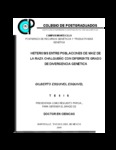Heterosis entre poblaciones de maíz de la raza chalqueño con diferente grado de divergencia genética
Abstract
Con el objeto de evaluar heterosis y los efectos de aptitud combinatoria general (ACG) y específica (ACE) en relación con la amplitud de origen geográfico en etapas tempranas del desarrollo y en productividad en campo, se evaluaron en un arreglo dialélico, diseño II de Griffing 15 poblaciones progenitoras nativas de maíz, sus 105 cruzamientos y otros genotipos adicionales de los Valles Altos de México. Se incluyeron poblaciones progenitoras cuyo origen se ubica en el área de distribución geográfica de la raza Chalqueño (Valles Altos de México) con antecedentes en programas de mejoramiento genético en los Valles Altos de México; ademàs, se incluyeron poblaciones nativas del área de la raza Chalqueño o sus variantes (Chalqueño-Celaya, Chalqueño-Cónico). Para evaluar vigor en etapas tempranas se usaron camas de arena en microtúnel, con siembras a 15 cm de profundidad. En campo, la siembra se realizó en tres localidades: Zotoluca, Apan, Hgo., Mixquiahuala, Hgo. y Santa Lucía, Texcoco, Edo. de México, en el ciclo agrícola Primavera-Verano de 2006 a una densidad de 50 mil plantas por hectárea. En ambas evaluaciones el diseño experimental fue un látice 12 x 12 con tres repeticiones, registrándose 15 variables para vigor inicial y 21 en campo, de las cuales se eligieron cinco y ocho, respectivamente por su gado de relevancia. Para vigor inicial, todas las variables mostraron diferencias altamente significativas (P≤0.01) entre grupos y entre poblaciones dentro de grupos, al igual que en la evaluación en campo, donde además se detectó que los efectos de ACG y ACE también fueron altamente significativos. Al considerar los efectos de ACG para las variables evaluadas en ambas fases del estudio se detectó que las poblaciones Méx-633, Col-03-64, Col-6784 y FHCH-129Fn de la raza Chalqueño, así como Gto-142, Tlax-151 y VS-22, variantes de la misma raza, presentaron la mejor expresión tanto para vigor de plántula como para rendimiento de grano y sus componentes. En ambas fases del estudio se registró un número de cruzamientos con efectos de ACE relevante, en los que se involucra a progenitores de origen geográfico divergente, denotando la capacidad de combinación entre ellos, atributo importante para identificar patrones heteróticos factibles de ser utilizados por los programas de mejoramiento genético de Valles Altos de México. En general, al considerar la evaluación per se en ambas fases del estudio, se detectaron cruzamientos que superaron a los híbridos comerciales testigo y la mejor heterosis se obtuvo cuando se cruzaron progenitores propios de la raza Chalqueño con variantes de dicha raza de origen geográfico relativamente lejano._________With the purpose of evaluating heterosis as well as general (GCA) and specific (SCA) combining ability effects at both early stages of maize development and field performance and productivity in relation to the amplitude of geographic origin, 15 native parental maize populations, their 105 crosses and some additional genotypes of the Mexican highlands were evaluated into a diallelic array, design II of Griffing. Native parental populations were selected according to such criteria as having origin within the geographic distribution area of Chalqueño race (Mexican highlands), populations with background in the Mexican highlands genetic improvement programs, besides, other populations were elected by searching wider geographic representativeness. For evaluating vigor in early stages sand beds under microtunnel were used, planting seeds at 15 cm depth. In the field, planting was carried out in three locations: Zotoluca, Apan, Hgo., Mixquiahuala, Hgo. and Santa Lucia, Texcoco, State of Mexico, in the Spring-Summer growing season, 2006 using a population density of 50 thousand plants per hectare. In both evaluations the experimental design was a 12 x 12 lattice with three replications; 15 traits were recorded for early vigor and 21 in the field evaluation; the five and eight more relevant traits, respectively were analyzed. For early vigor, all the traits showed highly significant differences (P≤0.01) among groups and populations within groups, as they did in the field evaluation, where in addition highly significant GCA and SCA effects were detected. When considering the GCA effects for the evaluated traits in both phases, Méx-633, Col-03-64, Col-6784 and FHCH-129Fn populations, belonging to the Chalqueño race, as well as Gto-142, Tlax-151 and VS-22, considered as variants of the same race, were detected as those displaying the best expression for both seedling vigor and grain yield and its components. In both phases of the study a number of crosses with outstanding SCA effects was registered, involving progenitors of divergent geographic origin, denoting the capacity of combination among them, which is important to identify heterotic patterns readily available to be used by breeding programs of the Mexican highlands. In general, when considering per se evaluation in both phases of the study, outstanding crosses were detected surpassing commercial hybrids used as checks and the best heterosis was obtained when true-to-type progenitors of the Chalqueño race were crossed to some variants of that race, from relatively remote geographic origin.
Collections
- Tesis MC, MT, MP y DC [186]


